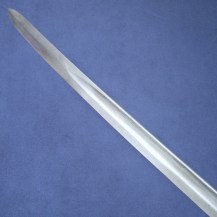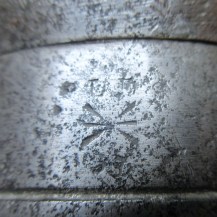Canadian 1890 Pattern Cavalry Trooper’s Sword, Princess Louise Dragoon Guards
Curved, single fullered blade, ambidextrous basket hilt with pierced Maltese Cross symbol and turned-over edges, black pressed leather grips secured by five steel rivets, brown leather washer. Steel scabbard with fixed opposed hanging rings. Overall length 39 inches (99.2cm) blade length 33½ inches (85.1cm). Traces of orange-brown paint to the lip of the guard on one side.
The spine of the blade is stamped with ‘/90’, indicating that it is an 1890 Pattern, and a crown inspection mark for Enfield. The flat of the blade is stamped at the forte on one side with a broad arrow and ‘EFD’, indicating War Department property made at Enfield, with another Enfield inspection mark. On the other side it is stamped with an issue mark for 1899, and two broad arrows point-to-point, a mark that was put on War Department equipment that was declared obsolete or to be sold off. The inside of the guard is stamped with ‘PLDG’, indicating the Princess Louise Dragoon Guards, and the sword number ‘51’.
The scabbard is stamped at the face side of the throat with two broad arrows point-to-point, below what appears to be ‘PLDG’ again – the ‘L’ and ‘D’ are most clearly visible with the other letters less visible due to shallower stamping and surface wear. The trailing side of the throat piece is stamped with the date ’96, a further crown inspection mark for Enfield and what look like the Roman numerals ‘II.’. The flat spine of the scabbard body is similarly stamped with a broad arrow and ‘WD’, indicating War Department property, another crown inspection mark for Enfield, the same ‘II.’ mark and the date ’96.
The PLDG originated in 1872 as the independent cavalry troop of the Canadian capital city of Ottawa. It gained the patronage of Princess Louise Caroline Alberta, the fourth daughter of Queen Victoria, during her time residing in the city. Louise’s husband John Campbell, the Marquess of Lorne, was appointed Governor General of Canada from 1878 to 1883, and she accompanied him as the viceregal consort. Her stay in Canada caused both excitement and uncertainty, Canadians not being accustomed to having royalty reside there, but left an enduring legacy: Lake Louise, Mount Alberta and the province of Alberta as a whole are named after her.
The Ottawa Troop of Cavalry therefore took on the much grander name of the Princess Louise Dragoon Guards from 1879, and was expanded to a full squadron. Being a militia regiment, it could not directly serve overseas, but volunteers from the PLDG served within the Imperial Yeomanry during the Boer War, earning the battle honour ‘South Africa, 1900’. The 1899 issue date on the blade of this sword raises the possibility that it may have issued for this deployment. While the brand new 1899 Pattern was in service by the time of the Boer War the PLDG, like many Canadian regiments, never received it and would have continued to carry the 1890 Pattern throughout.
The squadron was expanded again in 1903 to a full regiment and renamed the 5th “Princess Louise Dragoon Guards”. This regiment was once again not mobilised in its own right for the First World War, but contributed men to the 8th Regiment, Canadian Mounted Rifles. The PLDG was still using their 1890 Pattern swords and carried them across the Atlantic, but on arrival in England they were exchanged for the up-to-date 1908 Pattern. The 8th Regiment was broken up after its arrival, the majority of its cavalrymen sent to France to reinforce the 4th Battalion, Canadian Mounted Rifles. Fighting as infantry, enough of the former members of the 8th participated in the Battle of Mount Sorrel in 1916 to qualify for a battle honour, which ultimately passed to the PLDG after the formal disbandment of the 8th Regiment post-war.
In 1936 the 5th PLDG was merged with the 4th Hussars of Canada to form the 4th Princess Louise Dragoon Guards, which served as armoured car reconnaissance units within the Royal Canadian Armoured Corps during the Second World War, earning sixteen battle honours. The regiment became infantry in 1944 but retained some cavalry traditions, including having ‘squadrons’ and ‘troops’ of men rather than ‘companies’ and ‘platoons’. It was disbanded in 1965, and moved to the Supplementary Order of Battle as an inactive unit.
The blade has some scattered light pitting. It has been shortened by roughly 1 inch and repointed – this was probably done during service to repair a damaged tip. Some damage to the leather grips, including chipping at the edges and an abrasion on one side. Light handling wear to the chequering. The hilt and scabbard have some patination and pitting, some small dents to the scabbard towards the chape end. The leather washer fits a little loosely and may be a replacement.






















